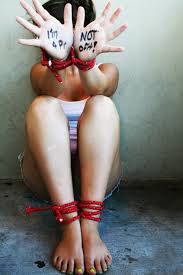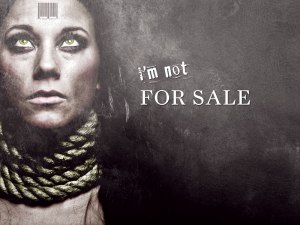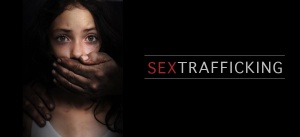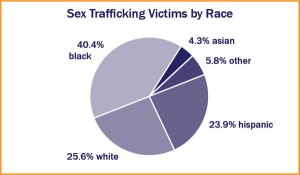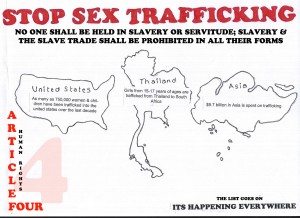What is Human Sex Trafficking?
Human sex trafficking is a form of slavery and involuntary servitude resulting in grave human rights violations. Sex trafficking involves individuals profiting from the sexual exploitation of others and has severe physical and psychological consequences for its victims (THE ADVOCATES HUMAN RIGHT, 2013).
Although anyone can become a victim of trafficking, it predominately affects women and children. Human sex trafficking violates women and children’s basic human rights, including the right to be free from slavery and slavery-like practices; the right to equal protection under the law; the right to be free from discrimination based on race, nationality, and gender; and the rights to life, security of person and freedom from torture. Governments also violate trafficked persons’ rights when they fail to prevent sex trafficking, prosecute perpetrators or provide trafficked persons with effective remedies for these violations, such as access to courts and legal immigration status (THE ADVOCATES HUMAN RIGHT, 2013).
Why Trafficking Exists
Like drugs and arms trafficking, human trafficking is a market-driven criminal industry that is based on the principles of supply and demand. Many factors make children and adults vulnerable to human trafficking. However, human trafficking does not exist solely because many people who are vulnerable to exploitation. Instead, human trafficking is fueled by a demand for cheap labor or services, or for commercial sex acts. Human traffickers are those who victimize others in their desire to profit from the existing demand. To ultimately solve the problem of human trafficking, it is essential to address these demand-driven factors, as well as to alter the overall market incentives of high profit and low risk that traffickers currently exploit (POLARIS PROJECT, 2013).
Why does demand thrive?
Labor trafficking and sex trafficking of U.S. citizens and foreign nationals persist and thrive for a number of reasons, including: (POLARIS PROJECT, 2013).
Low Risk: When the community is unaware of this issue, when government and community institutions are not trained to respond, when there are ineffective or dormant laws to address the crime, when safety nets for victims do not exist, and when law enforcement does not investigate and prosecute the crime, human traffickers perceive little risk or deterrence to affect their criminal operations (POLARIS PROJECT, 2013).
High Profits: When individuals are willing to buy commercial sex, they create a market and make it profitable for traffickers to sexually exploit children and adults.
When consumers are willing to buy goods and services from industries that rely on forced labor, they create a profit incentive for labor traffickers to maximize revenue with minimal production costs (POLARIS PROJECT, 2013).
Left unchecked, human trafficking will continue to flourish in environments where traffickers can reap substantial monetary gains with relatively low risk of getting caught (POLARIS PROJECT, 2013).
Demand For Labor Trafficking: What You Need To Know
Human trafficking victims make an alarmingly high number of consumer goods and food products that are both imported to the United States and produced domestically. More often than we realize, somewhere in the supply chain of the products we buy, elements of exploitative child labor or forced labor may be present. As economies around the world integrate, it has become faster and easier for goods produced with forced labor to enter the global market. In the U.S., labor traffickers exploit and enslave both foreign nationals (some of whom enter the U.S. legally) and U.S. citizens. (POLARIS PROJECT, 2013).
In many cases of labor trafficking, consumers provide the demand, and thus the profit incentive, to the traffickers. These consumers can include companies that subcontract certain types of services, end-consumers who buy cheap goods produced by trafficking victims, or individuals who use the services of trafficking victims. By changing purchasing choices and asking questions about how our products were made, consumers have the power to reduce these types of demand and help stop human trafficking (POLARIS PROJECT, 2013).
Demand For Sex Trafficking: What You Need To Know
Individuals who buy commercial sex acts create the demand for sex trafficking.
Many sex buyers may be unaware, ill-informed, or in direct denial of the abusive realities of sex trafficking situations as they exist within the broader sex trade. When sex trafficking is present, victims are often subjected to violence, threats, controlling behaviors, false promises, lies, and manipulation perpetrated by the traffickers/pimps. Popular media, including certain books, movies, television shows and music sometimes glamorize and romanticize the commercial sex industry without properly acknowledging the presence of sex trafficking. This glamorization then fuels the demand for paying someone else to have sex with them. Additionally, it is common that victims of trafficking will not discuss their situation with customers or ask for help because they are trained by their traffickers to lie and keep up the act. As a result, “johns” may not fully realize the truth behind the facade, or the pain behind the smile. In places and communities where there is a demand to bux sex, sex traffickers directly respond to the demand by seeking to offer a “product” to be sold for profit. To sex traffickers, the “product” they sell are the women and children they control (POLARIS PROJECT, 2013).
The federal Trafficking Victims Protection Act defines the crime of human trafficking as: (SHARED HOPE INTERNATIONAL, 2013)
A. The recruitment, harboring, transportation, provision, or obtaining of a person for the purpose of a commercial sex act where such an act is induced by force, fraud, or coercion, or in which the person induced to perform such act has not attained 18 years of age, or (SHARED HOPE INTERNATIONAL, 2013)
B. The recruitment, harboring, transportation, provision, or obtaining of a person for labor or services, through the use of force, fraud, or coercion for the purpose of subjection to involuntary servitude, peonage, debt bondage, or slavery.” (SHARED HOPE INTERNATIONAL, 2013)
Domestic minor sex trafficking occurs when U.S. citizen or lawful permanent resident minors (under the age of 18) are commercially sexually exploited. Children can be commercially sexually exploited through prostitution, pornography, and/or erotic entertainment (SHARED HOPE INTERNATIONAL, 2013).
The commercial aspect of the sexual exploitation is critical to separating the crime of trafficking from sexual assault, molestation or rape. The term “commercial sex act” is defined by the federal Trafficking Victims Protection Act as the giving or receiving of anything of value (money, drugs, shelter, food, clothes, etc.) to any person in exchange for a sex act (SHARED HOPE INTERNATIONAL, 2013).
The age of the victim is the critical issue — there is no requirement to prove force, fraud, or coercion was used to secure the victim’s actions. The law recognizes the effect of psychological manipulation by the trafficker, as well as the effect of threat of harm which traffickers/pimps use to maintain control over their young victim (SHARED HOPE INTERNATIONAL, 2013).
NEWS 1
On February 12, 2013, the Violence Again Women Act (VAWA) passed in the Senate with critical amendments made by Judiciary Committee Chairman Patrick Leahy’s (D-VT) to secure the reauthorization of the Trafficking Victims Protection Act (TVPA) as part of VAWA and by Senators Rob Portman (R-Ohio) and Richard Blumenthal (D-CT) to authorize grants to enhance the safety of youth and children who are victims of, or exposed to sex trafficking, domestic violence, dating violence, sexual assault, or stalking (SHARED HOPE INTERNATIONAL, 2013).
The Trafficking Victims Protection Act (TVPA) was enacted in 2000 to create tools to enable the U.S. government to address the prosecution of traffickers, protection for victims, and prevention of human trafficking. This Act serves as the cornerstone of legal protection for victims of trafficking at the federal level and sets a standard for state legislatures around the nation. For 18 years, VAWA has been the foundation of fighting violence, providing services and resources for victims of violence. Together these two statutes have enabled America to lead the world in protecting and delivering justice to victims of trafficking (SHARED HOPE INTERNATIONAL, 2013).
“National leadership is the key to combatting this crime,” said Linda Smith, President and Founder of Shared Hope International. “When our federal government takes a stance against trafficking, they reenergize the prioritization of innovative and effective solutions to this national crisis.” (SHARED HOPE INTERNATIONAL, 2013).
The TVPA serves as a baseline standard for Shared Hope’s Protected Innocence Challenge, a comprehensive analysis of existing state laws against a framework of legal components necessary to fully protect children from child sex trafficking. Under the Challenge, every state receives a Report Card that grades the state on 41 key legislative components that must be addressed in state’s laws in order to effectively respond to the crime of domestic minor sex trafficking. In addition, each state receives a complete analysis of this 41-component review and practical recommendations for improvement (SHARED HOPE INTERNATIONAL, 2013).
NEWS 2
Firefighter sentenced to 15 years in sex-trafficking case
Jamar Simmons, 31, brought women to Baltimore and hired them out as prostitutes (THE SUN, 2013)
By Ian Duncan, The Baltimore Sun
7:44 p.m. EST, December 13, 2013
A former Baltimore firefighter was sentenced to 15 years in federal prison for running a brothel and bringing women — including a 16-year-old girl — from around the country to Baltimore so he could hire them out as prostitutes (THE SUN, 2013).
Jamar Simmons, 31, ran a brothel with Franklin Coit, 35, and preyed on poor, homeless or otherwise vulnerable women, according to the U.S. attorney’s office. Simmons pleaded guilty in September to a federal sex trafficking charge; Coit had pleaded guilty to the same charge a month earlier (THE SUN, 2013).
The pair posted online advertisements falsely describing the women who worked for them as exotic dancers and arranged for them to meet clients at hotel rooms and other places in Maryland (THE SUN, 2013).
Simmons provided guidance to his employees, setting the pricing for various sex acts, training the women on how to set up dates and teaching them how to evade the police (THE SUN, 2013).
Coit and Simmons were also arrested on prostitution charges in Baltimore County in 2010. Simmons received probation before judgment in that case, and the charges against Coit were dropped (THE SUN, 2013)
William R. Buie III, Simmons’ lawyer, said the judge imposed a prison term longer than what both he and the government were seeking in the case (THE SUN, 2013).
“While I respect and understand the judge’s sentence, we were very hopeful of receiving a lighter sentence,” he said (THE SUN, 2013).
Coit’s attorney could not immediately be reached for comment.
Simmons will be required to register as a sex offender after his release (THE SUN, 2013).
HUMAN TRAFFICKING VICTIMS
Figure 1 : Victim.
Figure 2 : Im Not For Sale (Victim).
Figure 3 : Child Sex Trafficking.
HUMAN SEX TRAFFICKING STATISTIC
Diagram 1 : Sex Trafficking Victims by Race Statistic.
Diagram 2 : Sex Trafficking Statistic.
REFERENCE
POLARIS PROJECT. (2013, JUNE 24). Retrieved from WHY TRAFICKING EXIST: http://www.polarisproject.org/human-trafficking/overview/why-trafficking-exists
SHARED HOPE INTERNATIONAL. (2013, SEPTEMBER 20). Retrieved from WHAT IS SEX TRAFICKING: http://sharedhope.org/learn/what-is-sex-trafficking/
SHARED HOPE INTERNATIONAL. (2013, FEBRUARY 12). Retrieved from NEWS (TRAFICKING VICTIM): http://sharedhope.org/2013/02/12/the-trafficking-victims-protection-reauthorization-act-advances-in-the-senate-thanks-to-the-violence-against-woman-act/
THE ADVOCATES HUMAN RIGHT. (2013, MARCH 01). Retrieved from WHAT IS HUMAN SEX TRAFICKING: http://www.theadvocatesforhumanrights.org/what_is_human_sex_trafficking
THE SUN. (2013, DECEMBER 13). Retrieved from FIRE FIGHTER SENTENCED TO 15 YEARS IN SEX TRAFICKING: http://www.baltimoresun.com/news/maryland/crime/blog/bs-md-ci-fireman-sentenced-20131213,0,7177873.story
